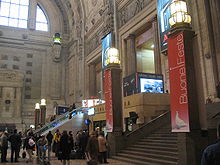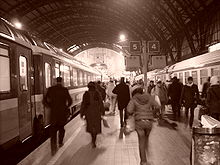- Milano Centrale railway station
-
For the district of Milan, see Stazione di Milano Centrale.
Milano Centrale 
Aerial view of the station building in 1964 Location Address Piazza Duca d'Aosta
20124 MilanoComune Milan Province Milan Region Lombardy Country Italy Coordinates 45°29′10″N 9°12′13″E / 45.48611°N 9.20361°ECoordinates: 45°29′10″N 9°12′13″E / 45.48611°N 9.20361°E Line(s) Milan–Bologna (high-speed)
Milan–Bologna (traditional)
Milan–Turin (high-speed)
Milan–Turin (traditional)
Milan–Genoa
Milan–Venice
Milan–Chiasso (–Zürich)
Milan–Domodossola (–Brig)
Milan–LeccoOther information Opened 1 July 1931 Architect Ulisse Stacchini Platforms 24 Owner Rete Ferroviaria Italiana Manager Grandi Stazioni Line operator(s) Trenitalia, FERROVIENORD, SBB, Deutsche Bahn, SNCF, Renfe, OBB Services 







Connections 
Metropolitana di Milano 
ATM trams 
ATM buses and trolleybuses
Airport busesLocation map Milano Centrale is the main railway station of Milan, Italy, and one of the main railway stations in Europe. The station is a railway terminus and was officially inaugurated in 1931 to replace the old central station (1864), which was a transit station and could not handle the new traffic caused by the opening of the Simplon tunnel in 1906. It is served by high speed lines to Bologna (to Rome and Naples) and Turin, and conventional railways to Bologna, Turin, Venice, Genoa, Domodossola (for the Simplon and Bern), Chiasso (for the Gotthard and Zürich Hauptbahnhof) and Lecco.
Contents
History
The first station
The first Milano Centrale station opened in 1864 in the area now occupied by the Piazza della Repubblica. It was designed by the French architect Louis-Jules Bouchot (1817–1907) and its architectural style was reminiscent of Parisian buildings of that period. This station was designed to replace Porta Tosa station (opened in 1846 as the terminus on the line to Treviglio and eventually Venice) and Porta Nuova station (opened in 1850 as the second terminus on the line to Monza, which was eventually extended to Chiasso) and was interconnected with all lines, either existing or under construction, surrounding Milan. It remained in operation until 30 June 1931, when the current station was opened. There is now no trace of it left.
Current station
King Victor Emmanuel III of Italy laid the cornerstone of the new station on April 28, 1906, before a blueprint for the station had even been chosen. The last, real, contest for its construction was won in 1912 by architect Ulisse Stacchini, whose design was modeled after Union Station in Washington, DC, and the construction of the new station began.
Due to the Italian economic crisis during World War I, construction proceeded very slowly, and the project, rather simple at the beginning, kept changing and became more and more complex and majestic. This happened especially when Benito Mussolini became Prime Minister, and wanted the station to represent the power of the fascist regime.
The major changes were the new platform types and the introduction of the great steel canopies by Alberto Fava; 341 metres long and covering an area of 66,500 square metres.
Construction resumed in earnest in 1925 and on July 1, 1931 the station was officially opened in the presence of Foreign Minister Galeazzo Ciano.
Its facade is 200 metres wide and its vault 72 metres high, a record when it was built. It has 24 platforms. Each day about 330,000 passengers use the station, totalling about 120 million per year.
The station has no definite architectural style, but is a blend of many different styles, especially Liberty and Art Deco, but not limited to those. It is adorned with numerous sculptures. “The ‘incongruous envelope of stone’ (Attilio Pracchi) of this gigantic and monumental building dominates Piazza Duca d’Aosta.” [1]
On September 25, 2006, officials announced a €100 million project, already in progress, to refurbish the station. Of the total cost, €20 million has been allocated to restore "certain areas of high artistic value" while the remaining €80 million will be used for more general improvements to the station to make it more functional with the current railway services. The project includes moving the ticket office and installing new elevators and escalators for increased accessibility.[2]
Services
The station has 24 tracks. Every day about 320,000 passengers pass through the station using about 500 trains, for an annual total of 120 million passengers. Trains connect to several European cites and many Italian long-distance and regional destinations. The station is also connected to Milan-Malpensa Airport.

Malpensa-Aeroporto 
Ferno-Lonate Pozzolo 

Busto Arsizio Nord 

Castellanza 

Rescaldina 


Saronno 


Milano Bovisa - Politecnico Milano Cadorna






Milano Porta Garibaldi




Milano Centrale



Platforms
Trains to various destinations leave platforms as follows:
- Platforms 1-3: Chiasso/Domodossola/TGV Milan-Paris/Milan-Turin (ES* AV)
- Platforms 4-6: Turin/Cisalpino Milan–Como–Arth Goldau–Basel / Zurich
- Platforms 7-13: Venice / Udine
- Platforms 14-17: Bologna–Florence–Rome–Naples
- Platforms 18-23: Genoa-Livorno / Ventimiglia / Parma /Cremona-Mantua /Milan-Treviglio-Bergamo
- Platform 24: Operations
Preceding station SNCF Following station toward Paris-LyonTGV Terminus Gallery
-
ETR 500 at Milan Central Station
See also
- Stazione di Milano Centrale
- Railway stations in Milan
- Railway stations in Italy
References
- ^ Touring Club Guida di Milano, p. 471
- ^ "100mln Euros to requalify Milan Railway Central Station". AGI. 2006-09-25. Archived from the original on 2007-01-05. http://web.archive.org/web/20070105135338/http://www.agi.it/english/news.pl?doc=200609251652-1149-RT1-CRO-0-NF11&page=0&id=agionline-eng.oggitalia. Retrieved 2006-09-28.
External links
Grandi Stazioni S.p.A. Shareholders 
Italy Bari Centrale · Bologna Centrale · Firenze Santa Maria Novella · Genova Brignole · Genova Piazza Principe · Milano Centrale · Napoli Centrale · Palermo Centrale · Roma Termini · Torino Porta Nuova · Venezia Mestre · Venezia Santa Lucia · Verona Porta NuovaCzech Republic  Railway stations in Milan
Railway stations in MilanGrandi Stazioni Centrale
Centostazioni RFI Certosa · Dateo · Greco Pirelli · Lancetti · Porta Genova · Porta Romana · Porta Venezia · Porta Vittoria · Repubblica · Romolo · San Cristoforo · VillapizzoneFERROVIENORD Defunct Bovisa FS · Bullona (2003) · Centrale vecchia (1931) · Lambrate vecchia (1931) · Porta Nuova I (1850) · Porta Nuova II (1864) · (1963) · Porta Tosa (1864) Urban rail transport in Milan
Urban rail transport in Milan Milan Metro
Milan Metro Suburban railwayS1 • S2 • S3 • S4 • S5 • S6 • S7 • S8 • S9 • S10 • S11ATM (Azienda Trasporti Milanesi) • Trenord • Milan trams • Railway stations in MilanCategories:
Suburban railwayS1 • S2 • S3 • S4 • S5 • S6 • S7 • S8 • S9 • S10 • S11ATM (Azienda Trasporti Milanesi) • Trenord • Milan trams • Railway stations in MilanCategories:- Buildings and structures in Milan
- Railway stations in Milan
- Railway stations opened in 1931
Wikimedia Foundation. 2010.









